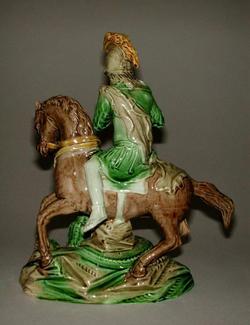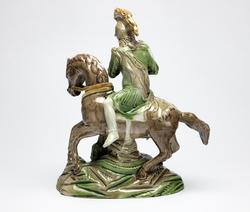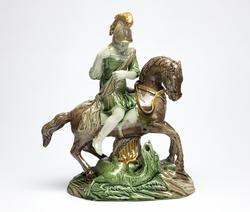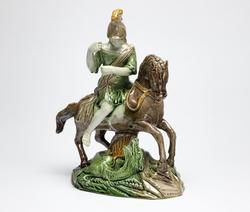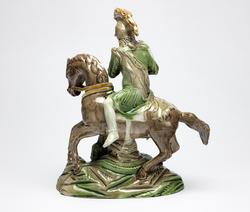Current Location: Gallery 27 (Glaisher)
Titles
St. George and the Dragon
Maker(s)
Potter:
Wood, Ralph, II
(Probably)
Potter:
Wood, Ralph, III
(Perhaps)
Entities
Categories
Description
Earthenware decorated with coloured lead glazes
Cream earthenware, press-moulded, and decorated with yellow, green, greyish-brown and brown lead-glazes. The underside of the base is open and unglazed, and has six ventilation holes in its sides and one in the centre. The figures are supported on a roughly oval rocky mound base with a tree stump in the middle. St George rides Roman fashion without stirrups on a spirited horse moving to the viewer's right with its tail streaming out behind. He wears a semblance of Roman military costume with a plumed helmet, and a long sash across his breastplate. He looks downwards and turns towards the viewer with both hands raised to grasp a spear (now missing) with which he is attacking the green and yellow dragon which writhes on the ground below him with its head raised and jaws open.
Notes
History note: John Henry Taylor (1849-1930); sold Sotheby's, 14 November 1930, Catalogue of the Valuable Collections of English Pottery & Porcelain, Glass, Objects of Vertu and Furniture, the Property of the late John Henry Taylor, Esq., Newstead, Birstall, Leicestershire, lot 580.
Legal notes
Purchased with the Glaisher Fund
Measurements and weight
Height: 25 cm
Length: 21.6 cm
Acquisition and important dates
Method of acquisition: Bought
(1930-11-14)
by
Sotheby's
Dating
18th Century, Late
George III
Circa
1782
CE
-
Circa
1795
CE
Note
Coloured glazed figures were probably introduced about 1780. The lead glazes, coloured with metallic oxides to produced green, yellow, brown, blue and grey, were painted onto the once-fired model, which was then fired again. The clear glaze over the flesh areas often had a slight green or blue tinge, and the latter may be very pronounced. There were numerous models, mainly of rural, classical and biblical subjects or animals.
The model for this splendid group of St George and the Dragon may have been inspired by a bronze by Francesco Fanelli (c. 1580-c. 1661), who worked in England during the reign of Charles I. It was in production by 16 November 1783 when an invoice in the Wedgwood archives records the sale by Ralph Wood to Josiah and Thomas Wedgwood of several figures including a dozen 'George & Dragons' at 2s. each. (Wedgwood MSS, 11496-12). Ralph Wood had returned to Burslem in the March 1782 after his business as a pottery dealer in Bristol ended in bankruptcy. After clearing his debts, he seems to have set up as a potter in Burslem by the late summer, as he supplied a small number of figures to Josiah Wedgwood in August 1782, and probably continued to produce them until his death in 1795 when his son Ralph III took over his factory. An example of this group has been recorded with the mark 'Ra. Wood/Burslem', and another marked 'R. WOOD'.
People, subjects and objects depicted
Components of the work
Decoration
Materials used in production
green, yellow, greyish-brown, and brown
Lead-glaze
Earthenware
Techniques used in production
Press-moulding
: Cream-coloured earthenware, press-moulded in parts, assembled, fired, painted in green, yellow greyish-brown, and brown lead glazes and fired again
References and bibliographic entries
Related exhibitions
Identification numbers
Accession number: C.40-1930
Primary reference Number: 74928
Glaisher Addition number: Gl. Add. 4-1930
Stable URI
Audit data
Created: Saturday 6 August 2011
Updated: Tuesday 30 April 2024
Last processed: Tuesday 15 July 2025
Associated departments & institutions
Owner or interested party:
The Fitzwilliam Museum
Associated department:
Applied Arts
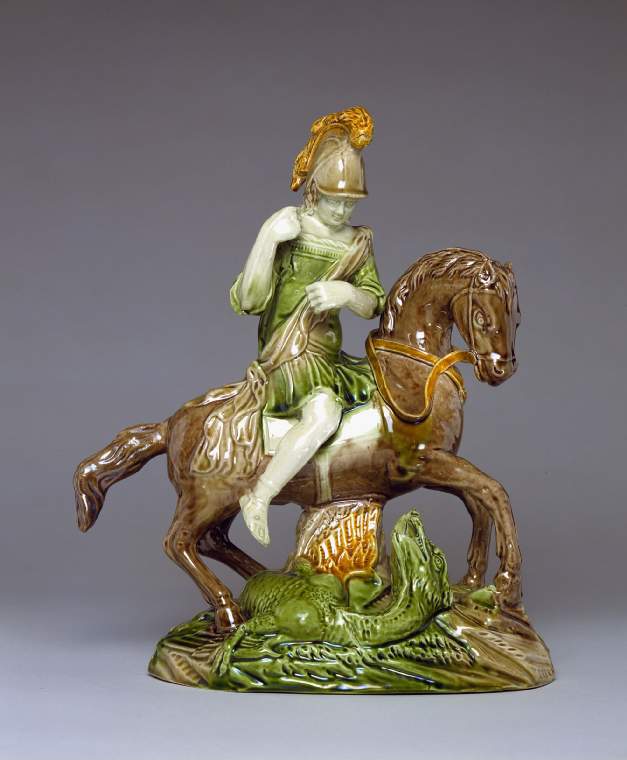
 IIIF Manifest
IIIF Manifest
